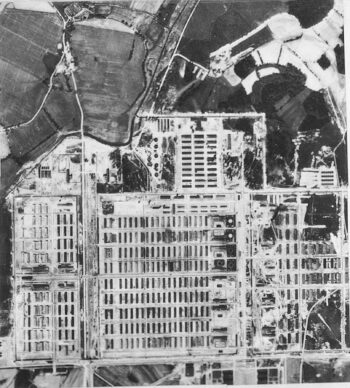In modern warfare, air superiority is crucial. It allows one to know where the enemy is, what he is doing, and to attack him at will with minimal repercussions. Taking aerial photos to explore enemy territory was, therefore, a top priority during World War II. Many of these photos, however, disappeared after the war into secret Allied archives.
aerial photos are prime evidence for investigating the Holocaust. Photos of alleged mass-murder locations, such as Auschwitz, Majdanek, Treblinka, Babi Yar etc., furnish insight into what did or did not happen there. Such photos can then be compared with what witnesses claim happened there, or with what should have been visible on those photos, if eyewitness statements are true. In fact, none of the photos taken of these locations corroborate commonly made claims.
In 1979, in the wake of the famous TV miniseries Holocaust, the CIA released a few aerial photos of the Auschwitz Camp in a brochure titled The Holocaust Revisited, claiming they prove that mass murder was indeed committed there at the time these photos were taken (Brugioni/Poirier 1979). Yet, a thorough analysis of the illustrations shows that their claims are partly unsubstantiated, and partly based on quite crude alterations of the original photos.
Additional aerial photos of the Auschwitz Camp have since been released, and photos from other suspected Holocaust crime scenes are accessible as well. Photos taken of other sites of mass murder and destruction unconnected to the Holocaust, such as the bombing of German cities, the Soviet mass-murder sites at Katyn, Poland, and mass graves dug in Western camps (such as Bergen-Belsen) that were devastated by epidemics, give realistic reference points as to what to expect on aerial photos of such locations.
Auschwitz

Top: Detail enlargement of an aerial photo of the Birkenau Camp of May 31, 1944, showing the area where huge pyres burning thousands of corpses daily were presumably located at that time.
Bottom: The same aerial photo as before but with smoke added via Photoshop to show how it would have had to look if the witnesses were telling the truth: massive formation of smoke.

During the time when the first Auschwitz aerial photos were taken – in May and June of 1944 – the mainstream narrative holds that, every day, ten thousand or more Jews deported from Hungary were killed and burned at Auschwitz-Birkenau, either in the cremation furnaces or, for the most part, on primitive outdoor pyres. The result of this gigantic mass-murder operation would have been (a) a dozen or more active pyres, (b) huge stockpiles of firewood, (c) widespread destruction of the surrounding ground vegetation by fire and heat, (d) large-scale movements of bodies, fuel and ashes, and most importantly (e) the area would have been covered under a thick layer of smoke.
But the photos show nothing. Among the 10 known Auschwitz aerial photos during 1944, not one of them shows even a single crematorium chimney with smoke. Four of the photos show small, campfire-sized plumes from a single location, which cannot represent more than a few dozen corpse-burnings, at most. The logical conclusion is that the claimed destruction of the Jews deported from Hungary between mid-May and mid-July of 1944 simply didn’t happen (Dalton 2020, pp. 234-243; Mattogno 2016b; Cox 2019, pp. 75-85).
Many witnesses claimed to have witnessed the burning of uncounted murdered Jews deported from Hungary on huge pyres outdoors at Auschwitz-Birkenau between mid-May and July 1944. This is a case of the “convergence of evidence” on a lie. It indicates that the origin of this claim is not personal experience, but black propaganda, rumor mongering, false-memory syndrome and/or coaching or even coaxing of witnesses by investigating judicial authorities. Here is a list of witnesses who made these false claims:
Shaul Chasan Berthold Epstein Chaim Frosch Olga Lengyel Maurice Lequeux Robert Lévy Salmen Lewental Pelagia Lewińska Henryk Mandelbaum Kurt Marcus Filip Müller Miklos Nyiszli Dov Paisikovic Joshuah Rosenblum Arnošt Rosin Josef Sackar Deszö Schwarz Henryk Tauber Morris Venezia Janda Weiss Elie Wiesel
Treblinka
At the Treblinka Camp, at least 700,000 corpses are said to have been cremated on pyres in a period of around 122 days (April – July 1943). Assuming the need of some 250 kg of fresh firewood to burn one corpse during open-air incinerations, this would have required some 175,000 metric tons of wood, or a corresponding number of trees. Witnesses claim they cut the tree from nearby forests. A 50-year-old spruce forest yields some 450 metric tons of wood per hectare (100 m × 100 m). This would mean that almost 390 hectares of forest were completely cut down (or 872 American-Football fields). This would have left a large area around this camp cleared of any forests. But there is not a trace of this on any Treblinka aerial photo (Rudolf 2020a, pp. 121-135; Kues 2009; Rudolf 2023, pp. 269-274).
Babi Yar
During the retreat of the German army from Kiev, the German air force took a high-resolution aerial photo of the area around Babi Yar. The photo was taken roughly a week after the 34,000 (or more) claimed victims of the Babi Yar mass murder are said to have been exhumed and cremated on huge pyres (Gutman, Vol. 1, pp. 113-115). However, this photo shows nothing indicating that any such human activity recently occurred. There is no disturbance of the soil from massive transports of fuels, no evidence that large mass graves were excavated, and no indication of the movement of soil, corpses, or ash remains. Furthermore, there is no sign of recent large pyres, and no indication of smoke in the vicinity. (Rudolf 2020a, pp. 153-156; Mattogno 2022c, pp. 523-579, 770-792).
By Holocaust Encyclopedia

Comments